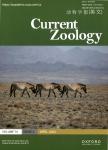Push and pull factors driving movement in a social mammal: context dependent behavioral plasticity at the landscape scale
作者机构:Agri-food and Biosciences InstituteVeterinary Science DivisionStormontBelfastUK School of Biological SciencesQueen's University BelfastBelfastUK Centre for Veterinary Epidemiology and Risk Analysis(CVERA)School of Veterinary MedicineUniversity College DublinBelfieldDublinIreland Department of AgricultureFood and the MarineAgriculture HouseDublinIreland Wildlife Conservation Research UnitDepartment of ZoologyUniversity of OxfordThe Recanati-Kaplan CentreTubney HouseAbingdon RoadTubneyAbingdonOxfordshireUK
出 版 物:《Current Zoology》 (动物学报(英文版))
年 卷 期:2019年第65卷第5期
页 面:517-525页
核心收录:
学科分类:0710[理学-生物学] 08[工学] 0805[工学-材料科学与工程(可授工学、理学学位)] 080502[工学-材料学]
基 金:Department of Agriculture, Food and the Marine (DAFM), Republic of Ireland University College Dublin Agri-food and Biosciences Institute, Belfast Poleberry Foundation
主 题:dispersal socio-biology wildlife biology wildlife disease Meles meles social groups territoriality perturbation bTB
摘 要:Understanding how key parameters(e.g.,density,range-size,and configuration)can affect animal movement remains a major goal of population ecology.This is particularly important for wildlife disease hosts,such as the European badger Meles meles,a reservoir of Mycobacterium bovis.Here we show how movements of 463 individuals among 223 inferred group territories across 755 km2 in Ireland were affected by sex,age,past-movement history,group composition,and group size index from 2009 to 2012.Females exhibited a greater probability of moving into groups with a male-biased composition,but male movements into groups were not associated with group composition.Male badgers were,however,more likely to make visits into territories than females.Animals that had immigrated into a territory previously were more likely to emigrate in the future.Animals exhibiting suchitinerantmovement patterns were more likely to belong to younger age classes.Inter-territorial movement propensity was negatively associated with group size,indicating that larger groups were more stable and less attractive(or permeable)to immigrants.Across the landscape,there was substantial variation in inferred territory-size and movement dynamics,which was related to group size.This represents behavioral plasticity previously only reported at the scale of the species’biogeographical range.Our results highlight how aone-size-fits-allexplanation of badger movement is likely to fail under varying ecological contexts and scales,with implications for bovine tuberculosis management.



